
Krabi-Krabong is a weapon-based martial art from Thailand. It is closely related to other Southeast Asian fighting styles such as Silat, Burmese banshay and Cambodian kbach kun boran. The royal bodyguard corps of the late King Bhumibol Adulyadej were said to be highly trained in krabi-krabong.

Banshay is a weapon-based martial art from Myanmar focusing primarily on the sword, staff and spear. Influenced by both Indian and Chinese sources, it is closely related to similar Southeast Asian systems such as Thai krabi krabong, Cambodian kbach kun boran and Malay silat.
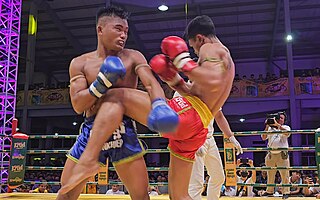
Kun Khmer, or Pradal Serey, is a combat sport that originated in Cambodia. The sport consists of stand up striking and clinch fighting, where the objective is to knock an opponent out, force a technical knockout, or win a match by points. The sport was codified in Cambodia by the French colonial administration in the early 20th century, and was derived from centuries-old traditions, namely Bokator, the close-quarter combat system used during the Khmer empire. The official Khmer name of the sport is Kbach Kun Pradal Khmer.

Lethwei or Burmese boxing is a full contact combat sport originating from Myanmar and is regarded as one of the most brutal martial arts in the world. Lethwei fighters are allowed to use stand-up striking techniques such as kicks, knees, elbows and punches, and the use of headbutts is also permitted. Fighters compete bareknuckle, wrapping their hands with only tape and gauze. Disallowed in most combat sports, headbutts are important weapons in a Lethwei fighter's arsenal, giving Lethwei its name of the "Art of nine limbs". This, combined with its bareknuckle nature, gave Lethwei a reputation for being one of the bloodiest and most violent martial arts. Although popular throughout modern Myanmar, Lethwei has been primarily and historically associated with the Karen people of the Kayin State; vast majority of competitive Lethwei fighters are ethnolinguistically of Karen descent.
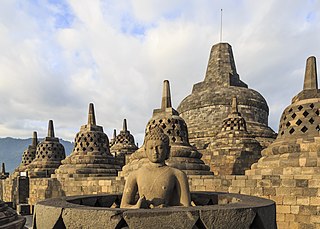
Buddhism in Southeast Asia includes a variety of traditions of Buddhism including two main traditions: Mahāyāna Buddhism and Theravāda Buddhism. Historically, Mahāyāna had a prominent position in the region, but in modern times, most countries follow the Theravāda tradition. Southeast Asian countries with a Theravāda Buddhist majority are Thailand, Cambodia, Laos, Myanmar, all of them mainland countries.
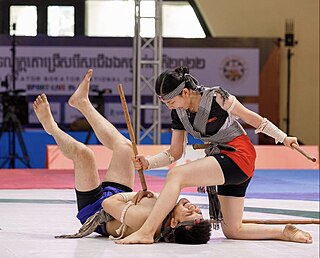
Bokator or Kun L'bokator is an ancient Cambodian battlefield martial art. It is one of the oldest fighting systems existing in the world and is recognised as intangible cultural heritage by the UNESCO.
The origins of Asian martial arts are diverse and scattered, having roots in various regions of Asia. Various Asian martial arts reference the study of animal movements as inspiration for martial arts techniques.
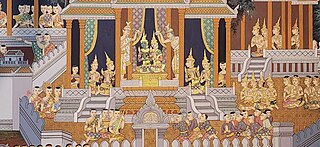
Cambodia has increasingly become involved in sports over the last 30 years.
This martial arts timeline is designed to help describe the history of the martial arts in a linear fashion. Many of the articles for particular styles have discussions of their history. This article is designed to help visualize the development of these arts, to help better understand the progression of the separate styles and illustrate where they interrelate.

Silat is the collective term for a class of martial arts from the Nusantara and surrounding geocultural areas of Southeast Asia. It is traditionally practised in Brunei, Indonesia, Malaysia, Singapore, Southern Thailand, Southern Philippines and Southern Vietnam. There are hundreds of different styles (aliran) and schools (perguruan) which tend to focus either on strikes, joint manipulation, weaponry, or some combination thereof.
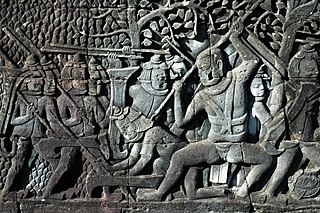
Kbach Kun Dambong Veng is a sub-discipline of Bokator. It involves the use of long staffs. In Cambodia, the discipline has historically been used to protect the country and villages from potential enemies.
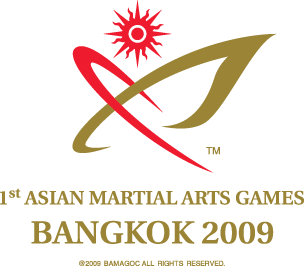
2009 Asian Martial Arts Games, officially the 1st Asian Martial Arts Games, were a pancontinential martial arts multi-sport event held in Bangkok, Thailand from 1 to 9 August 2009 with 9 events contested. Due to Political crisis in Thailand And 2009 Swine Flu, the Bangkok Asian Martial Arts Games Organizing Committee (BAMAGOC) and the National Olympic Committee (NOC) of Thailand decided that Asian Martial Arts Games moved from the original schedule of 25 April to 3 May to 1 to 9 August.
Kbach Kun Khmer Boran is the umbrella term encompassing all Khmer martial arts. Among them, figure Bokator, Kun Khmer, Baok Chambab and Kbach Kun Dambong Veng. Cambodian martial arts are a thousand-year old tradition, as evidenced by archeological vestiges.

Martial Arts Odyssey is an American web TV show with a martial arts travel theme. Created and hosted by Antonio Graceffo, the series has run more than 180 episodes shot in Taiwan, Thailand, Vietnam, the Philippines, Malaysia, Laos, Burma, and Cambodia. Martial arts featured on the show include: Muay Thai, Muay Chaiya, Pradal Serey, Bokator, Filipino Kuntaw, Mixed Martial Arts (MMA), Kung Fu, Silat Kalam, Silat Melayu, Tomoi, boxing, Muay Lao, Ziyou Bodji, urban combat, Lai Tai, Muay Boran, military hand-to-hand combat, Silambam, and others.
The traditional martial arts of the Mainland Southeast Asia are related to one another, and as a group to Indian martial arts. The most salient common feature is Mainland Southeast Asia kickboxing. The region of Mainland Southeast Asia is believed to be the land of Suvarnabhumi that ancient Indians mentioned in Buddhist text and Hindu text. In 790 A.D., a Khmer prince who grew up abroad by the name of Jayavarman II returned to unify the Khmer civilization. In 802 A.D., Jayavarman II established the Khmer Empire, the precursor to modern Cambodia, and declared himself the Chakravatin. Around 850 A.D., Pagan, the ancestor of modern-day Burma, was established by Tibeto-Burman speakers. For 200 years, Pagan remained a small principality until the reign of King Anawrahta. In 1238 A.D., Thailand's first state, Sukhothai, was started when the residents declared independence from the Khmer Empire. In 1353 A.D., Laos's first state, Lan Xang, was started by Fa Ngum with the assistance of the Khmer from Angkor.
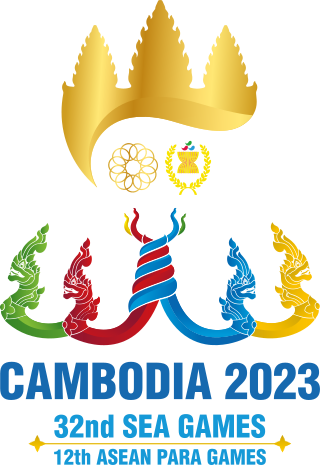
The 2023 Southeast Asian Games, also known as the 32nd Southeast Asian Games, or the 32nd SEA Games, and commonly known as Cambodia 2023, was the 32nd edition of the Southeast Asian Games, a biennial sports multi-sport event which was held from 5 to 17 May 2023 in Phnom Penh, Cambodia.

Jailbreak is a 2017 Cambodian action film directed by Jimmy Henderson. It was released in Cambodia in January 2017 and made available on Netflix in May 2018.
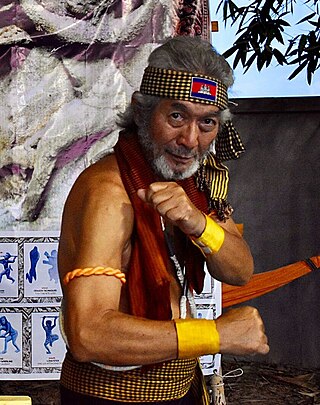
San Kim Sean is a Cambodian martial art teacher. He is often referred to as the father of modern Bokator and is largely credited with reviving the art. At age 13, he studied bokator under Master Khim Leak at Wat Mohamandrey. San Kim Sean also studied boxing under Master Chai Chheng in 1959 and 1960. He studied Judo under Kru So Meng Hong. and Hapkido under Korean master Chhay Yong Ho. San Kim Sean is the founder of the Cambodia Bokator Federation and the Cambodia Bokator Academy.
Tharoth Sam is a Cambodian actress and mixed martial artist specializing in the Khmer fighting style of Bokator. She has previously competed in ONE Championship.














